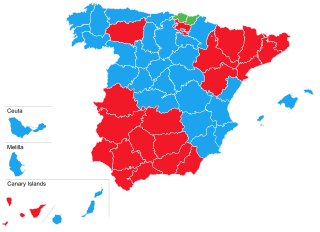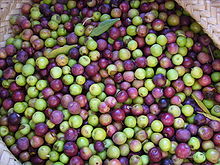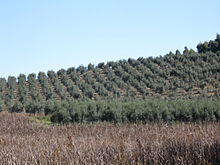
Zaragoza, also called Saragossa in English, is a province of northern Spain, in the central part of the autonomous community of Aragon. Its capital is the city of Zaragoza, which is also the capital of the autonomous community. Other towns in the province include La Almunia de Doña Godina, Borja, Calatayud, Caspe, Ejea de los Caballeros, Tarazona, and Utebo.
Spanish postal codes were introduced on 1 July 1984, when the Sociedad Estatal de Correos y Telégrafos introduced automated mail sorting. They consist of five numerical digits, where the first two digits, ranging 01 to 52, correspond either to one of the 50 provinces of Spain or to one of the two autonomous cities on the African coast.
Empeltre is a type of medium-sized, black olive originating in Spain. It is used both as a table olive and to produce a high-quality olive oil.
Spain has many coats of arms: the nation has one, the reigning monarch and the heir presumptive each have one, and there are others for the institutions of state and for Spanish regions and towns.
The Consejo Superior de los Colegios de Arquitectos de España (CSCAE), is the higher council of Architects Associations in Spain, and is the only established professional body of Spanish architects, located in the Paseo de la Castellana, Madrid.
The 2010–11 Copa del Rey was the 109th staging of the Copa del Rey. The competition began on 21 August 2010 and ended on 20 April 2011 with the final, held at the Estadio Mestalla in Valencia, in which Real Madrid lifted the trophy for the eighteenth time in their history with a 1–0 victory over Barcelona in extra time. Sevilla were the defending champions, but they were defeated by Real Madrid in the semi-finals.
Bien de Interés Cultural is a category in the Spanish heritage register. It covers various types of cultural heritage, which fall into sub-categories such as monuments, historic gardens, etc.

The 2013–14 Segunda División B season was the 37th since its establishment. The first matches of the season were played on 25 August 2013, and the season ended on 22 June 2014 with the promotion play-off finals.

The Picual, also known as Marteña or Lopereña, is an olive cultivar from Spain. Picual olives are the most commonly grown olive today for olive oil production, with production centered in the Spanish province of Jaén. Picual trees are estimated to account for 25% of all olive oil production in the world. Naturally, this varietal is very high in oil content, at 20-27% by weight.
The 2014–15 Copa del Rey was the 113th staging of the Copa del Rey. The winners assure a place for the group stage of the 2015–16 UEFA Europa League.
The 2015–16 Copa del Rey was the 114th staging of the Copa del Rey. Going into the tournament, the winners were assured a place for the 2016–17 UEFA Europa League Group stage. However, since the two finalists, Barcelona and Sevilla, both qualified for the 2016–17 UEFA Champions League, respectively by winning the 2015–16 La Liga title and the 2015–16 Europa League, the cup winner's place in the 2016–17 Europa League group stage instead passed to the fifth-place team in La Liga, Athletic Bilbao.

This is the results breakdown of the Congress of Deputies election held in Spain on 20 November 2011. The following tables show detailed results in each of the country's 17 autonomous communities and in the autonomous cities of Ceuta and Melilla, as well as a summary of constituency and regional results.

This is the results breakdown of the Congress of Deputies election held in Spain on 20 December 2015. The following tables show detailed results in each of the country's 17 autonomous communities and in the autonomous cities of Ceuta and Melilla, as well as a summary of constituency and regional results.

This is the results breakdown of the Congress of Deputies election held in Spain on 14 March 2004. The following tables show detailed results in each of the country's 17 autonomous communities and in the autonomous cities of Ceuta and Melilla, as well as a summary of constituency and regional results.

Manzanilla olives ("man-zah-nee-ya") or Manzanillo, also Manzanilla de Sevilla, originally from the area of Seville, Spain, are sometimes referred to as Spanish olives but along with Arbosana, Arbequina, Cacereña, Hojiblanca, Empeltre, and Gordal there are over two hundred varieties grown in Spain as well as other areas.
Miss World Spain 2016 was the 4th edition of the Miss World Spain pageant, held on September 17, 2016. The winner was Raquel Tejedor Melendez of Aragón and she represented Spain in Miss World 2016. This was the last edition of Miss World Spain under the Be Miss Organization. Later in the year, they give up the license to focus solely on Miss Universe Spain. The license then went to Nuestra Belleza España.
The history of the territorial organization of Spain, in the modern sense, is a process that began in the 16th century with the dynastic union of the Crown of Aragon and the Crown of Castile, the conquest of the Kingdom of Granada and later the Kingdom of Navarre. However, it is important to clarify the origin of the toponym Spain, as well as the territorial divisions that existed previously in the current Spanish territory.








